КОРРЕКЦИЯ СЕНСИБИЛИЗИРОВАННОГО СОСТОЯНИЯ У ЖИВОТНЫХ В ЭКСПЕРИМЕНТЕ СУММАРНЫМ ЭКСТРАКТОМ ФИТОКОМПОЗИЦИИ №3+PHYTO F
Гасанова Д.А.1, Гулиева С.Т.2, Ганиев М.М.3, Гасанова З.З.4
1ORCID -0000-0002-9626-8997, Кандидат медицинских наук, доцент кафедры фармакологии, Азербайджанский Медицинский Университет, 2Кандидат биологических наук, старший преподаватель кафедры фармакологии, Азербайджанский Медицинский Университет, 3Доктор медицинских наук, профессор кафедры фармакологии, Азербайджанский Медицинский Университет, 4Студент, Южно-Калифорнийский Университет
КОРРЕКЦИЯ СЕНСИБИЛИЗИРОВАННОГО СОСТОЯНИЯ У ЖИВОТНЫХ В ЭКСПЕРИМЕНТЕ СУММАРНЫМ ЭКСТРАКТОМ ФИТОКОМПОЗИЦИИ №3+PHYTO F
Аннотация
Целью нашего исследования было воздействовать на экспериментально сенсибилизированных животных экстрактом из лекарственных растений флоры Азербайджана для выявления некоторых сторон механизма фармакологического действия. Задачей исследования, является определение возможности коррекции с помощью суммарного экстракта Фитокомпозиции №3+PhytoF (Ф№3+PhytoF ) изучить системы защиты показателей иммунного (ЦИК, ГР, GSH), антиоксидантного (ПОЛ, МДА, КАТ, ЦП ) ответа организма морских свинок, сенсибилизированных введением 0,1 мл. нормальной лошадиной сыворотки. Изучить активность суммарного экстракта Ф№3+PhytoF в способности фармакологической защиты сенсибилизированного организма (с учётом ранее исследованных нами и, входящих в состав суммарного экстракта Ф№3+PhytoF и (Ф №1+ PhytoF). сумма флавоноидов из ряда природных злаковых, обладающих антирадикальной и АО активностями. Весьма малые дозы в пересчёте на рутин, на 30% подавляют реакцию хемилюминесценции (ХЛ), а так же они обладают не только высокой АО, но и высокой антирадикальной активностью по отношению к радикалам в реакции DPPH [16] .
Ключевые слова: сенсибилизация, циркулирующие иммунные комплексы (ЦИК), церулоплазмин (ЦП), востановленный глютатион (GSH), каталаза (КАТ).
Hasanova D.А.1, Guliyeva S.Т.2, Ganiyev М.М.3, Gasanova Z.Z.4
1ORCID -0000-0002-9626-8997, MD, Associate Professor of the Department of Pharmacology, Azerbaijan Medical University, 2MD, Senior Lecturer, Department of Pharmacology, Azerbaijan Medical University, 3MD, Professor, Department of Pharmacology, Azerbaijan Medical University, 4Student, University of Southern California
CORRECTION OF THE SENSITIZED CONDITION OF ANIMALS IN EXPERIMENTS WITH A TOTAL EXTRACT OF PHYTOCOMPOSITION №3 + PHYTO F
Abstract
The aim of our research was to affect experimentally sensitized animals with the extract from medicinal plants of the Azerbaijan flora for revealing some aspects of the pharmacological action mechanism. The objectives of the study were to determine the capability of correction with the total extract of Phytocomposition №3 + PhytoF (F№3 + PhytoF), to study the protection system of the indicators of the immune (CICs, GR, GSH) and antioxidant (LPO, MDA, CAT, CP) responses of the organism in guinea pigs sensitized by administering 0.1 ml normal horse serum. To study the activity of the total extract F№3 + PhytoF in the ability of the pharmacological protection of the sensitized organism (considering the previously studied by us and included in the total extract F№3 + PhytoF and (F№1 + PhytoF). The sum of flavonoids from a number of natural cereals have antiradical and antioxidant (AO) activities. Very small doses in terms of rutin inhibit chemiluminescence (CL) reaction by 30%, and they have not only a high AO, but also a high antiradical activity towards the radicals in the DPPH reaction [16].
Keywords: sensitization, circulating immune complexes (CICs), ceruloplasmin (CP), reduced glutathione (GSH), catalase (CAT).Evolution has created a system of protection from unwanted and sometimes destructive effects of external factors that surround us, and this system is called the immune system. The main work of the immune system is to maintain homeostasis, as well as the development of preventive means from such effects in the future. Immunity protects the organism from genetically foreign substances of exogenous and endogenous origins. The liver, containing a large part of natural killers, plays a special role in the immune system. Liver lymphoid populations provide stability to food antigens (Ag) and macrophages utilize immune complexes. The study of the immune status is an important part of clinical and experimental medicine and is realized for immunodiagnostics, i.e. determining the impaired link of the immune system, which causes the development of the disease.
Autoimmune and allergic diseases are immune system-related diseases. In autoimmune diseases the leading role belongs to autosensitization. The pathogenesis of autoimmune diseases is closely related to the accumulation of immune complexes (ICs) in the tissues. A long-term infection can lead to increased concentrations of circulating immune complexes (CICs) in the blood. One of the pathologies of immune complexes is serum sickness, which occurs upon parenteral administration of foreign serum and simulates the effect of persistent infection. Elevated levels of individual reactivity to Ag results in the development of allergy, anaphylactic reaction, which can occur in any organ as mast cells and basophils are found in many organs. Therefore, there is the concept of shock-organs. Arterioles and bronchi are the most affected in human. Analogical organ damage occurs in guinea pigs. [36]
The biological sensitization can be caused by bacteria and viruses (their Ag and toxins), many drugs, industrial poisons, as well as their own damaged proteins as a result of the formation of autoallergens, and also by globulins of the horse serum. Repeated exposure to allergens can cause allergic reactions such as anaphylaxis, serum sickness and Arthus phenomenon. Stages of the development of allergic reactions in many respects similar to the immunity development process and are also accompanied by fixation of allergens in cells and in the elaboration of antibodies (Ab). Biological sensitization and immunity may develop in parallel. The general principles of the occurrence and development of sensitization were studied using active sensitization to serum allergens as an example. Thus, the guinea pigs were injected subcutaneously with 0.01 ml of horse serum or solutions of another protein allergen [1]. CICs are physiological defenders of the organism, which facilitate rapid removal of endogenous and exogenous Ag. Normally, CICs formed in the bloodstream, are phagocytosed and destroyed. Massive complexes are destroyed in the spleen and liver. CICs are formed at every interaction of At with Ag, and if they are not destroyed, they are deposited in the organs and tissues for a long time, wherein the reaction of hypersensitivity or the disease of immune complexes with the formation of anaphylatoxins and infiltration of areas of the deposition of CICs occurred. Small immune complexes may accumulate in various organs and tissues and cause inflammation and damage to biological structures. With an increasing size (with excess Ag) complexes can be deposited in the perivascular space and in the cortical layer of the kidney, causing inflammatory processes [21]
Ulcerative colitis (UC) is accompanied by the activation of humoral immunity and the formation of ICs. Appearance of CICs in the serum of patients with UC is regarded as prognostically unfavorable sign, indicating that the disease may be accompanied by extraintestinal manifestations. Detection of the CICs is of great clinical diagnostic and prognostic value [28, 18]
High concentrations of CICs are observed in extraintestinal manifestations of UC [3, 40, 41]
CICs are directly related to erythrocytes and they are also present in plasma in free forms. CICs bound to erythrocytes do not have any damaging effects on the organism. Therefore, the problem of determining their level is very important today. Determination of CICs in blood allows assessing disease activity, but does not reflect the amount of immune complexes deposited in tissues [20, 24, 19]
Biopsy of the tissue, which confirms the deposition of ICs in the affected tissue, is recommended during the development of the disease.[19, 3, 40]
CICs may be formed due to the lack of "information" in the immune system with respect to antigens, intruded into the organism. So instead of destroying Ag, antibodies form compounds with them. Pathological processes occur in the background of the formation of reactive oxygen species (ROS) and intensification of the free radical oxidation of biosubstrates. In response, activation of the cell antioxidant system (AOS) occurs. AOS are presented by low molecular compounds - radical traps, which include vitamins A, C, E and K, bioflavonoids, low molecular weight thiols, and antioxidant enzymes - superoxide dismutase (SOD), glutathione peroxidase (GP), glutathione reductase (GR), catalase (CAT) and ceruloplasmin (CP) [4, 22, 29]
CP having radioprotective, immunomodulatory, immunoprotective [33, 2, 9] and antioxidant [42] properties, increases the resistance of hepatocytes to damaging toxic factors. Thanks to ferroxsidase activity, CP prevents the formation of free radicals and the development of lipid peroxidation (LPO) [34, 9].
The sum of flavonoids from natural cereals such as Calamagrostis epigejos, Daschampsia caepitosa, which are included in the content of Phytocomposition №3 + Phyto F (F№3 + Phyto F) have a good antioxidant (AO) activity. Very small doses in terms of rutin inhibit chemiluminescence (CL) reaction by 30%, and they have not only high AO, but also a high antiradical activity towards the radicals in the DPPH reaction [16].
Glutathione system is involved in the processes of metabolism of xenobiotics and antiradical protection. Glutathione serves as a reserve of cysteine in the cell and affects the functional activity of lymphocytes, providing an immune response and glutathione AOS. Glutathione reductase / glutathione peroxidase (GR / GP) system is an essential component of the antioxidant defense (AOD) of the organism [38], supporting the intensity of the free radical oxidation (FRO) [38, 25, 23].
The role of GR is to maintain the concentration of reduced glutathione (GSH) without increasing its synthesis. Recently enzyme specific bioassay systems have been created using GR to assess target biological activity of the antioxidant and adaptogenic orientation in pharmacologically active substances [39].
Some catalytic properties of the enzyme were studied in animal [30, 31] and human [15, 17] tissues under normal conditions. However, they have not been investigated in the sensitized organism yet.
The aim of the research. To affect experimentally sensitized animals with the extract from medicinal plants of the Azerbaijan flora for identifying some aspects of the pharmacological action mechanism. The objective of the study was to determine the capability of correction of the indicators of immune response using the total extract of Phytocomposition №3 + PhytoF (F№3 + PhytoF). Then to study the antioxidant defense systems of the organism by determining the activity of the total extract F№3 + PhytoF in the ability of pharmacological protection of the sensitized organism (considering previously studied by us and included in the total extract F№3 + PhytoF and F №1 + PhytoF). The sum of flavonoids from a number of natural cereals have antiradical and antioxidant (AO) activities. Very small doses in terms of rutin inhibit chemiluminescence (CL) reaction by 30%, and they have not only a high AO, but also a high antiradical activity towards the radicals in the DPPH reaction [16].
The total extract of Phytocomposition №3+PhytoF contains: М Pomifera, Calamagrostis epigejos, Daschampsia caespitosa [16] , Heracleum L., Echinops ritro L., Alfalfa, containing Mg, Glycyrhiza glabra, containing selenium (Se), Artemizia Absinti, containing vitamin C, Phytoncides, essential oils (thujone and terpenes), Althaeae off. containing mucus, pectin, Heracleum sibiricum, containinig carotene and vitamin C., + Zn, and also plants containing a prebiotic inulin (ID), which is recycled by the microflora of the large intestine, strengthens the immune system and has a positive effect on the liver function, Paliurus spina-christi Mill, containing alkaloids, saponins, tannins, and sucrose, as well as the following flavonoids: hyperin, rutin and isoquercitrin [26]
In our research we have evaluated the immunomodulatory effect of F№3 + PhytoF, with above mentioned herbs in its composition, and its ability to activate natural protective immune responses.
Materials and methods
The studies were conducted with guinea pigs, which were in a required diet [35] in three series: I- intact, II- comparison and III- test group. A physiological solution of the corresponding volume was administered to intact animals. Animals of both (II and III) series were sensitized by subcutaneous injection of 0.1 ml normal horse serum. Blood samples were taken from the animals of all three series on the 15th day to analyze the presence of the circulating immune complexes (CICs) in the serum - the test of the first level, which was performed by the method of Digeоn [5]
Reduced glutathione (GSH), malondialdehyde (MDA) and catalase (CAT) were assayed to determine LPO and the state of the pro-antioxidant balance. The animals of the test series received the total extract of F№3 + PhytoF during 15 days. After blood sampling, intracardiac administration of the shocking dose of horse serum (0.5ml) was performed with the animals of the II and III series. Catalase was determined by the method of [6] MDA was determined by the method of Yagi et.al. (1968) modified by Yagi (1976). Ceruloplasmin (CP) was determined by the method of O.B. Severina et. al. [32]
Results
In the control series of the experiments anaphylactic reaction in animals occurred after 2 minutes and the following symptoms were observed: scratching the nose (grooming), ruffled fur, decreased body temperature, sneezing, spastic cough, convulsive jumps, convulsions. Then the animals took the lateral position, they urinated and defecated, then spasm of the respiratory tract occurred and the animals died. The animals of the comparison group died after 5-8 minutes.
In the test series of the animals after the administration of the shocking dose within 4-5 minutes mild signs appeared: weak and momentary convulsions, grooming, and weak spasm of the respiratory tract. All these symptoms disappeared within 1.5 minutes and actually, the violated functions restored completely. Symptomatology has also been confirmed by the laboratory tests (Table 1).
Table 1 - Effect of the total extract of Phytocomposition №3 + Phyto F on the change in the immune status of sensitized guinea pigs

Note: Confidence intervals (M ± Δ) are shown in the section STATISTICS.
(M ± Δ) was calculated by the Student's criterion. Confidence intervals are indicated on the first line (* - with a probability p <0.01; ** - with a probability p <0.05), minimum and maximum values are on the second line.
Coefficient of the immune status monitoring (CISM) was calculated by the formula: CISM=(P-T)/(P-I), where T, P, and I are values obtained for test, pathological and intact groups, respectively.
Coefficient of the immune status monitoring (CISM) determines essentially the activity of F №3 + Phyto F used for the treatment. Maximum activity, as can be seen in Table 1 is equal to 9.67 (Section - Interval of values; line – small / max). This is explained by the large intervals of the values for “small” in the intact (22-904) and comparison (798- 2954) groups. Due to the high activity of F №3 + F Phyto after the treatment the interval of values shrank to (36-49) (Figures 1, 2, 3).
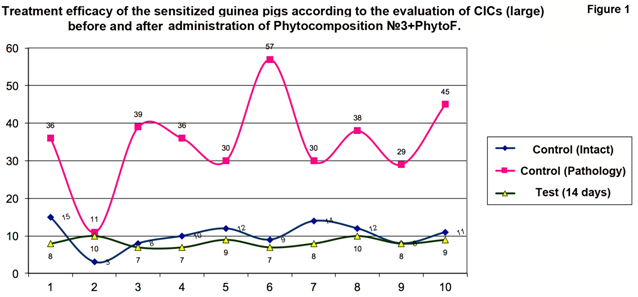
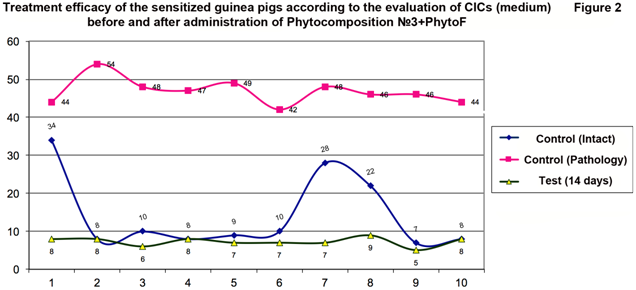

Monitoring the pro - antioxidant balance in sensitized guinea pigs showed activation of the process of lipid peroxidation (LPO), as evidenced by enhanced levels of malondialdehyde (MDA) (Figure 4) in blood,
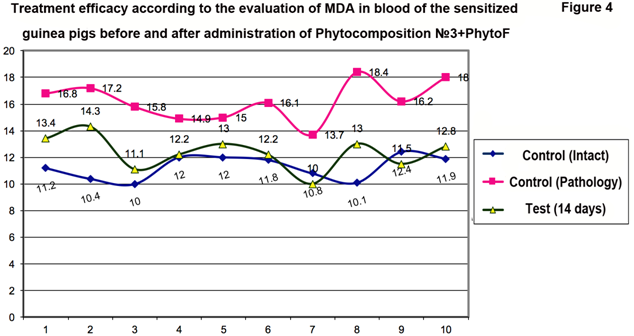
and a decline in antioxidant and immune defense accompanied by a sharp increase in small CICs (Table 1).
The administration of F№3 + PhytoF reduced the intensity of lipid peroxidation, which was manifested by the decrease in the MDA content relative to the comparison group. We observed also changes in relation to the antioxidant system (Figures 5 and 6),
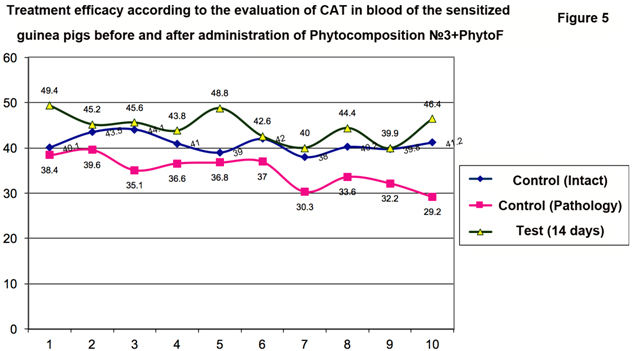
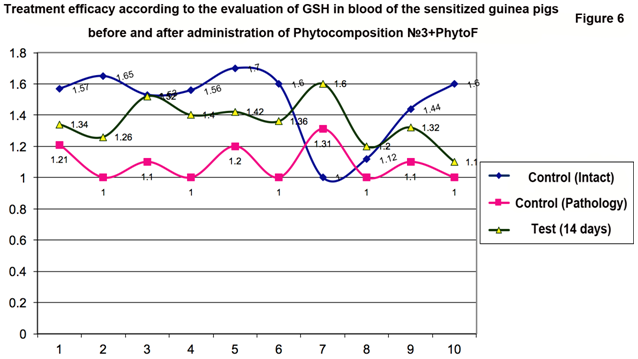
manifested by a significant stimulation of CAT and GSH activities (Table 2) and increased synthesis of CP in relation to the control group (Table 4 №).
Table 2 - Statistical processing of the results of experiments studying blood parameters of sensitized guinea pigs before and after the administration of Phytocomposition №3 + Phyto F (M + - m, n = 10)
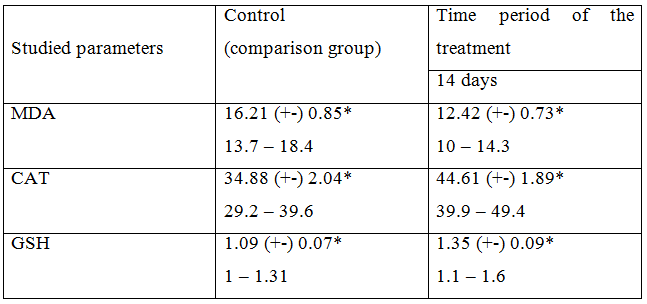
NOTE: The confidence intervals are indicated on the first line (* - with a probability P<0.01; ** - with a probability P <0.05)
Table 4 - Statistical processing of the results of experiments studying CP changes in serum of sensitized guinea pigs before and after the administration of Phytocomposition №3 + Phyto F (M +- m, n = 10)

NOTE: The confidence intervals are indicated on the first line (* - with a probability P <0.01; ** - with a probability P <0.05)
It can be explained by the ability of F№3+PhiуtoF to decrease inflammatory process [10] the stimulation of the immune defense system upon intruding Ag and thereby, the decrease in LPO activation in tissues (Table 3).
Table 3 - Statistical processing of the results of experiments studying MDA changes in the liver of sensitized guinea pigs before and after the administration of Phytocomposition №3 + Phyto F (M +- m, n = 10)

NOTE: The confidence intervals are indicated on the first line (* - with a probability P <0.01; ** - with a probability P <0.05). The second line shows minimal and maximal values of the parameter.
The antioxidant effect can also be explained by the presence of microelements Fe, Zn, Cu, F in №3 + PhytoF as impurities, which are coenzymes of major antioxidant enzymes (superoxide dismutase, catalase, glutathione peroxidase, and ceruloplasmin), as well as vitamins C, K, A, and can also be attributed to the presence of flavonoids (FLs) in its composition. FLs are biologically active substances formed in plants having antioxidant properties and they activate enzymes when ingested. There are more than hundred species of FLs, in particular rutin, likviritin and catechins (12 species of catechins have been identified), one of which (EGC-3-G), contained in the leaves of green tea (extract from which is a part of F№3 + PhytoF ), has an antioxidant effect, the strength of which is superior to vitamin C a hundred times. Catechins - flavonoids are excellent antioxidants, polyphenols and they inhibit free radicals in the organism [7].
Antioxidants reduce the damage to the internal organs caused by free radicals, which are generated when Ag enters the body. The immediate response to changes in the intensity of lipid peroxidation observed in the sensitized guinea pigs is related to the increase in the contents of ceruloplasmin (CP) and CAT (Table 2, 4). The copper-containing protein CP responds first to changes in the activity of free radical oxidation. This is due to detoxifying, hepatoprotective, [14] antioxidant and antiradical effects of CP, as well as its high resistance to ROS.
In allergic reactions in the sensitized organism the immune system is primarily damaged and inflammatory reactions appear. These changes are associated with the activation of lipid peroxidation process and adaptive changes to oxidative stress. Considering the fact that the liver plays an important role in the reduction of the sensitized state (disruption of the large ICs occurs in the liver and spleen), the hepatoprotective effect of CP is important in this situation [14]. F№3+PhytoF increases the content of CP in the sensitized organism of guinea pigs and maintains its high level for 21 days (Figure 7).
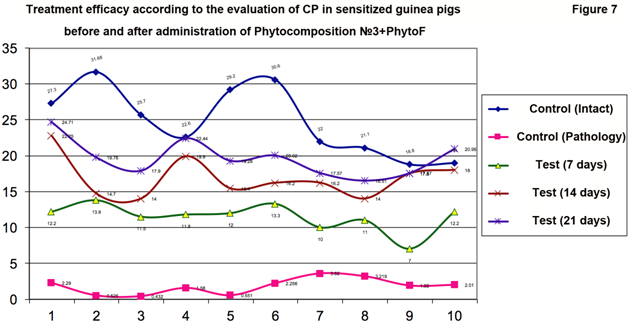
Amounts of all CICs (large, medium and small) in the blood serum of the comparison group of the sensitized animals were found to be increased.
In the III series of the experiments amounts of CICs in the sensitized animals decreased significantly and approached the parameters obtained for the intact animals upon the administration of F№3+Phуto. This suggests that free ICs are actively destroyed and phagocytized [11].
The increased GSH activity plays an important role in this process which is stimulated by the total extract of F№3 + Phyto. Glutathione serves as a reserve of cysteine in the cell and effects on the functional activity of lymphocytes, providing an immune response, which is a glutathione AOS.
In some cases, medium and large circulating immune complexes disappeared completely. This can be observed in the evaluation of the treatment efficacy of the sensitized guinea pigs according to the generalized blood parameters (GBP), estimated using the formula GBP=CAT x GSH/MDA (Figure 8).
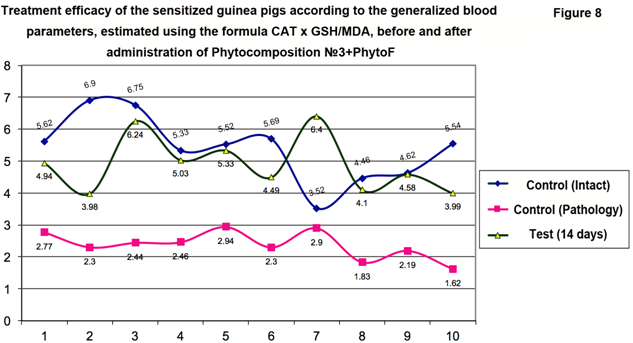
The total extract F№3 + PhytoF includes plants that contain prebiotic - inulin. Inulin strengthens the immune system and has a positive effect on the liver function. Moreover, the sum of flavonoids from a number of natural grasses studied by us and included in F№1 + PhytoF and F№3 + PhytoF have the antioxidative effect and also a high antiradical activity [16]. Therefore, the positive therapy of the sensitized animals is also suggested to be associated with the antiradical activity of F№3 + PhytoF.
CP having radioprotective, immunomodulatory, immunoprotective [33, 2, 9] and antioxidative properties, enhances resistance of hepatocytes to the oxidative stress [37] and to the damaging toxic factors. Thanks to ferroxsidase activity, CP prevents the formation of free radicals and the development of lipid peroxidation (LPO) [2, 34, 27].
Catalase relates to enzymes that maintain their activities for a long time. This enzyme is defined in human and animal organisms, in erythrocytes, in the liver and kidneys. It prevents the accumulation of hydrogen peroxide, i.e. its role is associated with the antioxidant protection [12].
We conclude that medicinal plants included in the phytocomposition have immunosuppressive effects in anaphylaxis. We suggest that plants with antioxidant, and antiradical activities as well as those plants that possess adaptogenic properties, increasing resistance to hypoxia and increasing endurance (Artemizia Apsinthi, Echinops, Heracleum, Dischampsia), which we studied earlier, play an important role.
Conclusions
- The total extract of F№3 + PhytoF reduces amounts of free, circulating immune complexes damaging organs.
- The mechanism of action of the total extract of F№3 + PhytoF is explained by the intensification of AOS in the sensitized organism.
References
- Ado A. D, General Allergology, M., 1970; Immunological diseases, 2 ed., v. 1-2, Boston, 1971.
- Alsederova A.S. Immunoprotective effect of ceruloplasmin during the acute period in patients who underwent the critical state of various genesis // Anesthesiology and reanimatology. - 1992.- № 2.-pp. 43-45].
- Burmester G. R., Pecutto A. Naglyadnaya immunologiya.[6. Burmester G.R., Petsutto A., including Ulrikhsa T. Eikher A. Demonstrative Immunology // Demonstrative medicine. Translated from English.-2009-Moscow]. [in Russian]
- Bustamante D. i dr. Metabolizm alfa – lipoevoi kisloti v pecheni pri razlichnix formax patologii. [ Bustamante D. et al. The metabolism of a-lipoic acid in the liver in various forms of pathology // International Medical Journal.- 2001.-№2- pp. 133 -142.; [in Russian]
- Digeоn M, Lover M., Riza S., Racle S.F. // Detection of circulating immune complexes in human sera by simplified assays with polyethylene glycol. 1977, v.16., p. 165-183
- Goryachkovski A.M., Clinical Biochemistry, 1998).
- Green Tea. www.ayzdorov.ru/tvtravnik_relennii_chaii.php
- Guseynli I.S., Dadashova S.B., Hasanova D.A. et al. The study of antioxidant and antiradical activities of extracts from several plants of the Azerbaijan flora// Proceedings of the IX International Symposium June 14-18, 2011, pp. 155-158, Pushchino, Volume I, Moscow.
- Hasanova D. Correction of the Natural Metabolite – Ceruloplazmin Secretion by Phytocompozition № 1+PhytoF in Toxic Hepatitis // Allergy, Asthma and Immunophysiology Recent Advances in understanding and Management.- VIII World Asthma, allergy and COPD Forum and XXI World Congress on Rehabilitation in Medicine and immunoreabilitation. Singapore, April 26-29, 2015,- pp. 101-107.
- D. A. Hasanova. Phytocomposition in the general allergy of the organism // XX world congress on rehabilitation in medicine and immunorehabilitation. Allergology and Immunology. 2014 V15.- № 1.- 62.- ISSN 1562-3637.- VII World Forum on Asthma and Respiratory Allergy.- New York, USA. - 26-29 April 2014]
- Hasanova D.A., Huseynova F.D. Azerbaijan Medical University, Baku, Azerbaijan. Pharmacological correction of the sensitized status by the phytocomposition from the Azernaijan Flora. // XX world congress on rehabilitation in medicine and immunorehabilitation. - VII World Forum on Asthma and Respiratory Allergy. 2014 V 15 - №1, ISSN 1562-3637 63, - April 26-29, 2014, New York, USА
- Hasanova D. A. Azerbaijan Medical University, Baku, Azerbaijan. On the hepatoprotective properties of the phytocomposition. // XX world congress on rehabilitation in medicine and immunorehabilitation.-VII World Forum on Asthma and Respiratory Allergy- V15.- № 1. -2014 - ISSN 1562-363763- 26-29 april -New York, USA. 2014.
- Hasanova D. Correction of the Natural Metabolite – Ceruloplazmin. Secretion by Phytocomposition № 1+PhytoF in Toxic Hepatitis // Allergy, Asthma and Immunophysiology. Recent Advances in understanding and Management.- VIII World Asthma, allergy and COPD Forum and XXI World Congress on Rehabilitation in Medicine and immunoreabilitation. Singapure, April 26-29, 2015,- pp. 101-107
- Hasanova D.А., Hasanova Z.Z. the role of ceruloplasminin the α2- globulin fraction of protein metabolism in the liver induced by carbon tetrachloride and its correction by Phytocomposition №1 + PhytoF // International Research Journal ISSN 2303-9868 PRINT ISSN 2227-6017 ONLINE.- №8 (50).- 147-155.-2016.]
- Huang J. Distribution of glutathione and glutathione-related enzyme systems in mitochondria and cytosol of cultured cerebellar astrocytes and granule cells / J. Huang, M.A. Philbert // Brain Res. V.680, № 1-2. - 1995. -pp. 16-22.
- Huseynli I. Sh., Dadashova S.B., Hasanova D.A. i dr. Issledovanie antioksidantnoi I aniradikalnoq akivnostei ekstraktov iz ryada rastenii flori Azerbaidjana. [21. Husynli I.S., Dadashova S.B., Hasanova D.A., et al. The study of antioxidant and antiradical activities of extracts from several plants of the Azerbaijan flora// Proceedings of the IX International Symposium, June 14-18, 2011, pp. 155-158, Pushchino, V1, Moscow] [in Russian]
- Hwavg C. Oxidized redox state of glutathione in the endoplasmic reticulum // C. Hwavg, A.J. Sinsky, H.F. Lodish // Science. 1992. - № 257. -pp. 1496-1502.
- Khaitov R.M., Pinegin B.V., Rukovodstvo k klinicheskoi immunologii I diagnostiki zabolevanii immunnoi sistemi. [Khaitov R.M., Pinegin B.V., Yarilin A.A., Manual of clinical immunology. Diagnostics of the immune system diseases // Guidelines for doctors. - M., 2009.-p. 345 ] [in Russian]
- Lapin S. V., Totolyan A. A. Immunologicheskaya laboratornaya diagnostika autoimmunnix zabolevanii. [Lapin S.V., Totolyan A.A. Immunological laboratory diagnostics of autoimmune diseases // SPB .: -Human. 2010. - p. 272] [in Russian]
- Mail D. Immunology / Translated from English.- M .: Logosfera, 2007.- p. 586
- Medicinckaya Diagnosticheskaya laboratoriya “VERA” [Medical Diagnostic Laboratory "VERA".//Normalnii put laboratornogo obsledovaniya bolnich s infarktom miokarda. [Normalized path of the laboratory examination of patients with myocardial infarction. http://www.medn.ru/statyi/cirkuliruyushhi.html, http://www.vera-lab.ru/analizes] [in Russian]
- Manoli L. et al. Effects of chronic variable stress on oxidative stress in rat cerebral cortex / // Rev. Farm, e bioquim. Univ. Sao Paulo. 1998. -№34. - p. 188.
- Montero S. et al. / A study of the kinetic mechanism followed by glutathione reductase from mycelium of Phycomyces blakesleeanus // Arch. Biochem. Biophys. 1990. - V. 278. - pp. 52-59].
- Nazarenko G.I., Kishkun A. Klinicheskaya ocenka laboratornix issledovanii. [Nazarenko G.I., Kishkun A. Clinical evaluation of the laboratory research results.- M.: Medicine. -2000.-p. 533] [in Russian]
- Pashkov A.N. Vliyanie melatonina na oksidativnii status, soderjaniya citrate I aktivnost akonitatgidrotazi v pecheni kris pri toksicheskom gepatite. [Pashkov A.N. et al. The effect of melatonin on oxidative status, citrate content and aconitate hydratase activity in the liver of rats with toxic hepatitis // II Problems of endocrinology. 2005 -V. 51, №6.-pp. 41 – 43] [in Russian]
- Luma T.Ahmed, Khulood W.AL-Sammarie, Nabel KH.AL-Ani, Basim M.Jaber The Inhibition Effect of Paliurus Spina-Christi Methanolic Extract on Trichophyton Mentagrophytes Growth and Tri M4 Gene // Diyala Journal of Medicine, April 201, Vol. 4, Issue 1, p. 109
- Sanina O.A., Berdinskikh N.K. The biological role of ceruloplasmin and the possibility of its clinical application. Literature review // Problems of Medical Chemistry - 1986.-V. 32, Issue 5, pp. 7-14].
- Saginbayev V.E., Lazebnik L.B. Povishenie soderjaniya cirkuliruyushich immunnich kompleksov pri yazvennom kolite. [Saginbayeva V.B., Lazebnik L.B. Increasing content of circulating immune complexes -s1q and S3d as a criterion of the aggravation of extraintestinal manifestations in ulcerative colitis // Experimental and clinical gastroenterology № 7 (107) / 2014, pp. 18-24] [in Russian]
- Scapagnini G. et al. Long-term ethanol administration enhances age-dependent modulation of redox state in brain and peripheral organs of rat: Protection by acetyl carnitine / // Int. J. Tissue React. 2002. - № 3. - pp.89-96.]
- Schulr G.E. High resolution structure and catalytic reaction of human glutathione reductase / G.E. Schulr, A. Karplus // Biochem. Soc. Trans. -1988.-V.12, №2.- pp.81-84.
- Schulz G.E. FAD-binding site of glutathione reductase / G.E. Schulz, R.H. Schirmer, E.F. Pai // J. Mol. Biol. 1982. - V. 160. - pp. 287-308].
- Severina O.B., Bacevich V.V., Basova R.V., Gavrish I.N., Yaropolov A.I. The quantitative determination method of ceruloplasmin // Laboratory case. 1986-№10-pp.618-620]. [in Russian]
- Tarasenko M. Y. Profilaktika I kechenie ojegovix anemii. [Tarasenko M. Y. Prevention and treatment of anemia in burn patients: Dis. Candidate of Medicine Sciences SP 6, 1995.- p. 24] [in Russian]
- Zakirova A.N. Kliniko-gemadinamicheskie effekti antioksidanta ceruloplazmina u bolnix ishemicheskoi bolezni serdca [Zakirova A.N., Clinical - hemodynamic effects of the antioxidant- ceruloplasmin in patients with coronary artery disease // Therapeutic archive- 1995.- V. 67, №4.- pp. 33-35] [in Russian]
- Zapadnyuk I.P., Zapadnyuk V.I., Zachariya E.A. Laboratornie jivotnie. Razvedenie, soderjanie I ispolzovanie v eksperimente. [Zapadnyuk I.P., Zapadnyuk V.I., Zachariya E.A. Laboratory animals. Breeding, maintenance, use in the experiment. Kiev: Naukova Dumka, 1983. pp. 195-297] [in Russian]
- Zvereva V.V., Boichenko M.N. Medicinskaya mikrobiologiya, virusologiya I immunologiya // [Zvereva V. V., Boychenko M.N. Medical Microbiology, Virology and Immunology. - M.: GEOTAR Media, 2010. – p. 448] [in Russian]
- Vavilova T.P., Gusarova Y.N., Korolyova O.V., Medvedyev A.E. The role of ceruloplasmin in the development of neoplastic processes // Biomed. chemistry- 2005.-V 51, Issue 3.- pp. 263-275]
- Vladimirov Y. A. Svobodnie radikali v jivix sistemax. [Vladimirov Y.A. Free radicals in living systems / Y.A. Vladimirov, O.A. Azizova, A.I. Deyev // Results of science and technology. Series in Biophysics. VINITI, 1991. - V. 29. - pp. 1-252] [in Russian]
- Vladimirov Y.A.Biologicheskie membrane I nezaprogramirovannaya c smert kletki. Vladimirov Y.A. Biological membranes and unprogrammed cell death / Y.A. Vladimirov // Soros Educational Journal. 2000-V.6, №9, - pp.2-9] [in Russian]
- Vorobyev A. A., Bikova A. S., Karaulova A.V. Immunologiya I allergologiya. [Vorobyev A.A., Bikova A.S., Karaulova A.V. Immunology and Allergology: Tutorial for medical students - M .: Practical medicine, -2006. –p. 288; [in Russian]
- Vorobyev G. I. Chalif I. L. Nespecificheskie vospolitelnie zabolevaniya kishechnika. [Vorobyev G.I., Khalif I.L. Non-specific inflammatory bowel disease // M .: Miklosh, -2008. – p.400] [in Russian]
- [Yaropolov A.N. The mechanisms of antioxidant action of ceruloplasmin. // Reports of the Academy of Sciences of USSR.-1986.- V. 291. № 1.- pp. 237-241] [in Russian]
